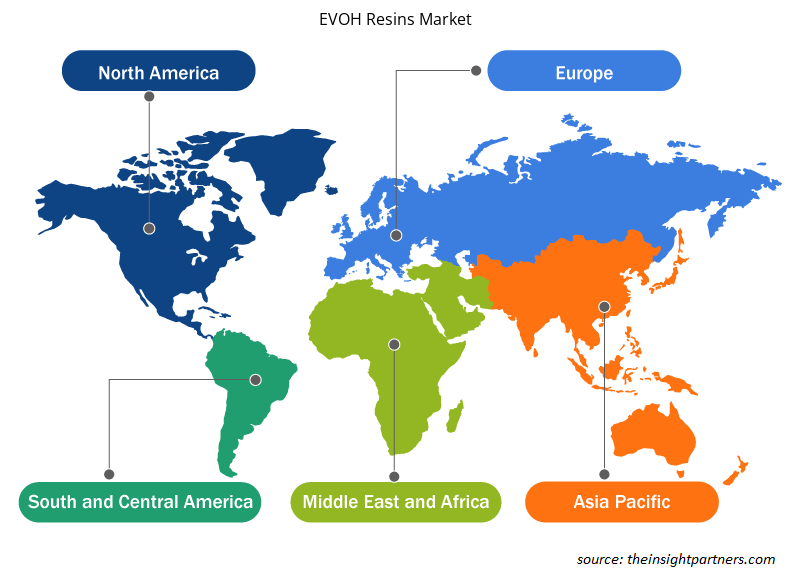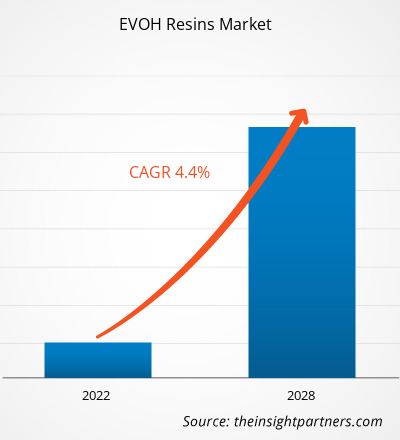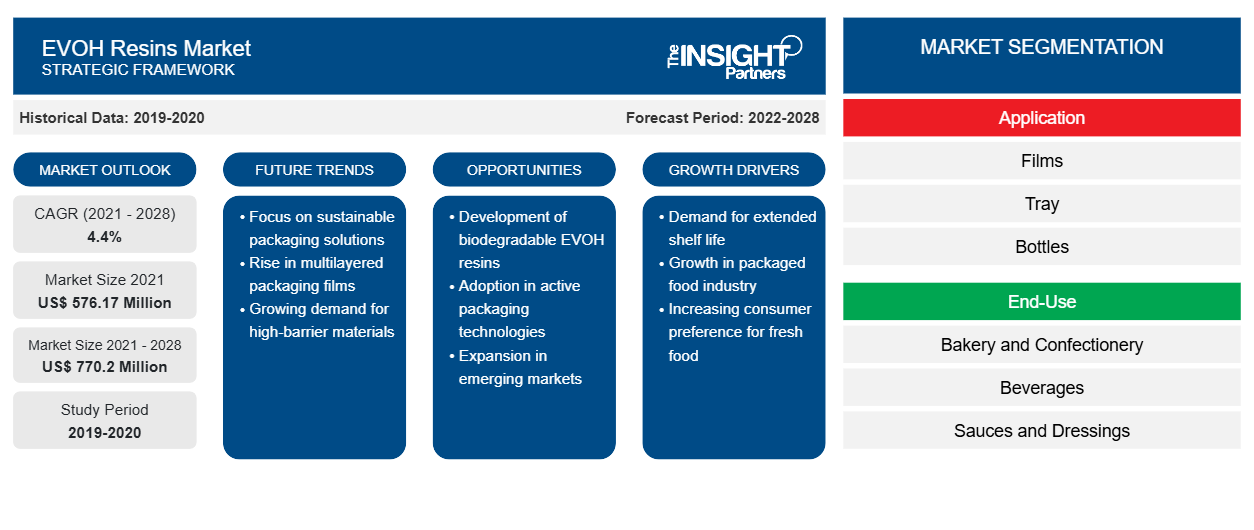Der Markt für EVOH-Harze für Lebensmittelanwendungen wurde im Jahr 2021 auf 576.173,9 Tausend US-Dollar geschätzt und soll bis 2028 770.199,9 Tausend US-Dollar erreichen. Von 2021 bis 2028 wird eine durchschnittliche jährliche Wachstumsrate (CAGR) von 4,4 % erwartet.EVOH resins market for food application was valued at US$ 576,173.9 thousand in 2021 and is projected to reach US$ 770,199.9 thousand by 2028. It is expected to register a CAGR of 4.4% from 2021 to 2028.
Das steigende Umweltbewusstsein der Verbraucher und strenge staatliche Vorschriften in Bezug auf giftige Verpackungen treiben die Nachfrage nach EVOH-Harzen im Lebensmittelsektor an. Um die Umweltverschmutzung zu reduzieren, setzen Hersteller auf umweltfreundliche Verpackungslösungen, was wiederum den Verkauf umweltfreundlicher Materialien ankurbelt. Regierungen und Hersteller stellen Mittel für die Forschung und Entwicklung innovativer Verpackungslösungen zur Verfügung. Darüber hinaus neigen Verbraucher zunehmend zu umweltfreundlichen, kohlenstoffarmen Produkten, um die Abfallverschmutzung zu vermeiden. EVOH-Verpackungen sind umweltfreundlich, da sie einen geringen CO2-Fußabdruck aufweisen und leicht recycelt werden können. Im Gegensatz zu Kunststoff- und Papierbehältern entstehen keine Abfälle und es muss kein Holz für die Rohstoffe gefällt werden. Diese Vorteile erhöhen die Nachfrage nach EVOH-Harzen für umweltfreundliche Lebensmittelverpackungen und treiben das Marktwachstum voran.EVOH resins in the food sector. To reduce environmental contamination, manufacturers are adopting eco-friendly packaging solutions, which, in turn, boosts the sales of eco-friendly materials. Governments and manufacturers are providing funds to research and develop innovative packaging solutions. Further, consumers are increasingly inclined toward green, low-carbon products to eliminate waste pollution. EVOH packaging is environmentally friendly because it has a low carbon footprint and can be easily recycled. Unlike plastic and paper containers, it does not produce waste and does not need wood cutting for raw materials. These benefits increase the demand for EVOH resins for eco-friendly food packaging, propelling the market growth.
Im Jahr 2020 hatte der asiatisch-pazifische Raum den größten Anteil am weltweiten Markt für EVOH-Harze für Lebensmittelanwendungen . Der Hauptfaktor, der zum Wachstum des Marktes in dieser Region beiträgt, ist die steigende Nachfrage nach EVOH-Harzen in verpackten Lebensmitteln. Verbraucher bevorzugen gesunde Lebensmittel mit hohem Nährwert, niedrigem Cholesterinspiegel, Konservierungsstoffen und Fetten. EVOH findet Anwendung in verschiedenen Lebensmittelverpackungsprodukten, wie zum Beispiel Fleischverpackungen, Babynahrungsverpackungen und Getränkeverpackungen. Diese Faktoren treiben die Nachfrage der Hersteller im Land nach EVOH-Harzen. Die zunehmende Neigung der Verbraucher zu verpackten Lebensmitteln aufgrund ihres geschäftigen Lebens hat die Nachfrage nach EVOH-Harzen für Lebensmittelverpackungsanwendungen prognostiziert. Die indische Mittelschicht wächst und mit ihr ihre Kaufkraft und Ansprüche. Die Menschen bevorzugen Premiumprodukte, insbesondere im Süßwarensegment wie Schokolade, Chips und vieles mehr, und interessieren sich für verpackte Lebensmittel in der Kategorie Fertiggerichte und leicht zu verzehrende Produkte, was Möglichkeiten für EVOH-Harze für Lebensmittelverpackungsanwendungen schafft.
Passen Sie diesen Bericht Ihren Anforderungen an
Sie erhalten kostenlose Anpassungen an jedem Bericht, einschließlich Teilen dieses Berichts oder einer Analyse auf Länderebene, eines Excel-Datenpakets sowie tolle Angebote und Rabatte für Start-ups und Universitäten.
-
Holen Sie sich die wichtigsten Markttrends aus diesem Bericht.Dieses KOSTENLOSE Beispiel umfasst eine Datenanalyse von Markttrends bis hin zu Schätzungen und Prognosen.
Auswirkungen der COVID-19-Pandemie auf den EVOH-Harzmarkt für LebensmittelanwendungenEVOH Resins Market for Food Application
Die COVID-19-Pandemie hatte im Jahr 2020 schwere Auswirkungen auf den Weltmarkt, da die Lieferketten für die Herstellung von EVOH-Harzverpackungen unterbrochen waren. Die Lockerung der Lockdown-Maßnahmen in mehreren Ländern und die Wiederaufnahme der Betriebstätigkeit in vielen Branchen haben dazu beigetragen, dass EVOH-Harze in Lebensmittelverpackungen ab 2021 wiederbelebt wurden. Darüber hinaus hat das schnelle Tempo der COVID-19-Impfprogramme das Wachstum des EVOH-Harzmarktes für Lebensmittelanwendungen unterstützt.EVOH resin packaging. Ease in lockdown measures in several countries and resumption of operational activities in many industries have helped revive EVOH resins in food packaging from 2021. In addition, the rapid pace of COVID-19 vaccination programs has supported the growth of the EVOH resins market for food application.
Markteinblicke:
Verbraucher bevorzugen Online-Vertriebskanäle zum Kauf von EVOH-Folien, was den Markt für EVOH-Harze für Lebensmittelanwendungen begünstigtEVOH Films Favors EVOH Resins Market for Food Application
Verbraucher bevorzugen Online-Vertriebskanäle, um EVOH-Folien für Lebensmittelverpackungen zu kaufen. Daher konzentrieren sich viele Unternehmen auf die Entwicklung von E-Commerce-Websites, um die Kundenbindung zu erhöhen. Branchenanalysen zeigen auch, dass die steigende Nachfrage nach EVOH-Folien bei Endverbrauchern durch sich ändernde Markttrends getrieben wird. Darüber hinaus unterstützt eine zunehmende Verbreitung von Smartphones die Nachfrage nach EVOH-Folien. Digitale Inhalte, Reisen und Freizeit, Finanzdienstleistungen und E-Mail sind E-Commerce-Optionen, die einem internetfähigen Kundenstamm zur Verfügung stehen und mit zunehmender Internetnutzung an Bedeutung gewinnen. Daher wird erwartet, dass sich das Bewusstsein der Verbraucher für die Technologie im Prognosezeitraum positiv auf die Nachfrage nach EVOH-Harzen auf dem Lebensmittelverpackungsmarkt auswirken wird.EVOH films for food packaging. Therefore, many companies focus on developing e-commerce websites to increase customer engagement. Industry analysis also indicates that the rising demand for EVOH films among end users is driven by changing market trends. In addition, an increase in smartphone penetration is supporting the EVOH films demand. Digital content, travel and leisure, financial services, and e-mail are e-commerce options available to an internet-accessible customer base, gaining traction as internet usage grows. Therefore, consumer awareness of the technology is expected to positively impact the demand for EVOH resins in the food packaging market during the forecast period.
Darüber hinaus hat die COVID-19-Pandemiekrise die Funktionsweise des E-Commerce verändert. Der Anstieg kleiner und mittlerer Unternehmen, insbesondere in Russland, und die zunehmende Zahl von Start-ups haben zur Einführung von Online-Marktplätzen für Unternehmen geführt. Bestehende Organisationen und große Unternehmen tendieren dazu, Geschäfte online abzuwickeln, da Telekommunikation und Infrastruktur billiger sind. E-Commerce ermöglicht es Unternehmen, Kunden zu erreichen, um die gewünschten Geschäftsergebnisse leicht zu erzielen. Daher wird das starke Wachstum des Online-Einzelhandelssektors für EVOH-Folien in Europa in den kommenden Jahren lukrative Möglichkeiten für den Markt bieten.EVOH films would provide lucrative opportunities for the market in the coming years.
Anwendungseinblicke
Je nach Anwendung ist der Markt in Folien, Schalen, Flaschen, Bag-in-Box und andere unterteilt. Hersteller verwenden EVOH-Flaschen aufgrund ihrer hervorragenden Barriere gegen Gase und organische Flüssigkeiten. EVOH wird häufig zwischen die innere und äußere Kunststoffwand der Flasche oder des Gefäßes eingelegt. Zwischen der EVOH-Schicht und der inneren und äußeren Wand befindet sich eine dünne Klebeschicht. Daher wird EVOH häufig als Mehrschichtbarrieretechnologie bezeichnet. Diese EVOH-Flaschen werden im Allgemeinen für haltbare Getränke verwendet. Getränke sind leicht verderblich; daher können sie leicht verunreinigt werden, wenn sie mit der Außenumgebung in Kontakt kommen. Aufgrund dieser Faktoren steigt die Nachfrage nach EVOH-Flaschen bei Getränkeherstellern und wird voraussichtlich das Wachstum des Segments in der Region im Prognosezeitraum weiter vorantreiben.EVOH bottles for their excellent barrier against gases and organic liquids. EVOH is often sandwiched between the bottle or jar's inner and outer plastic walls. A thin adhesive layer goes between the EVOH layer and the inner and outer wall. As a result, EVOH is often referred to as a multilayer barrier technology. These EVOH bottles are generally used for shelf-stable beverages. Beverages are highly perishable; thus, they can contaminate easily when it comes in contact with the outer environment. Due to these factors, the demand for EVOH bottles is increased among beverage manufacturers and is further expected to drive the segment's growth in the region over the forecast period.
Zu den wichtigsten Marktteilnehmern auf dem Markt für EVOH-Harze für Lebensmittelanwendungen zählen Kuraray Europe GmbH; Nippon Gohsei (UK) Limited; Kureha Europe BV; Chang Chun Group; Eval Europe NV; Soarus LLC (Mitsubishi Chemical Europe GmbH); Schur Flexibles GmbH; Gantrade Corporation; The Compound Company BV; Soarnol; Arkema; Solvay SA; Diese Unternehmen bieten ein breites Produktportfolio für den Markt für EVOH-Harze für Lebensmittelanwendungen.EVOH resins market for food application are Kuraray Europe GmbH; Nippon Gohsei (UK) Limited; Kureha Europe B.V.; Chang Chun Group; Eval Europe NV; Soarus L.L.C. (Mitsubishi Chemical Europe GmbH); Schur Flexibles GmbH; Gantrade Corporation; The Compound Company BV; Soarnol; Arkema; Solvay S.A.; These companies provide a wide range of product portfolios for the EVOH resins market for food application.
Diese Unternehmen sind in Entwicklungsregionen vertreten und bieten eine lukrative Chance für den EVOH-Harzmarkt. Diese Marktteilnehmer konzentrieren sich stark auf die Entwicklung hochwertiger, innovativer Produkte, um die Kundenanforderungen zu erfüllen.EVOH resins market. These market players are highly focused on developing high-quality, innovative products to fulfill customer requirements.
Regionale Einblicke in den EVOH-Harzmarkt Resins Market Regional Insights
Die regionalen Trends und Faktoren, die den Markt für EVOH-Harze im Prognosezeitraum beeinflussen, wurden von den Analysten von Insight Partners ausführlich erläutert. In diesem Abschnitt werden auch die Marktsegmente und die Geografie von EVOH-Harzen in Nordamerika, Europa, im asiatisch-pazifischen Raum, im Nahen Osten und Afrika sowie in Süd- und Mittelamerika erörtert.EVOH Resins Market throughout the forecast period have been thoroughly explained by the analysts at Insight Partners. This section also discusses EVOH Resins Market segments and geography across North America, Europe, Asia Pacific, Middle East and Africa, and South and Central America.

- Erhalten Sie regionale Daten zum EVOH-Harzmarkt
Umfang des Marktberichts zu EVOH-Harzen
| Berichtsattribut | Details |
|---|---|
| Marktgröße im Jahr 2021 | 576,17 Millionen US-Dollar |
| Marktgröße bis 2028 | 770,2 Millionen US-Dollar |
| Globale CAGR (2021 - 2028) | 4,4 % |
| Historische Daten | 2019-2020 |
| Prognosezeitraum | 2022–2028 |
| Abgedeckte Segmente |
Nach Anwendung
|
| Abgedeckte Regionen und Länder |
Nordamerika
|
| Marktführer und wichtige Unternehmensprofile |
|
Dichte der Marktteilnehmer für EVOH-Harze: Auswirkungen auf die Geschäftsdynamik verstehen
Der Markt für EVOH-Harze wächst rasant, angetrieben durch die steigende Nachfrage der Endverbraucher aufgrund von Faktoren wie sich entwickelnden Verbraucherpräferenzen, technologischen Fortschritten und einem größeren Bewusstsein für die Vorteile des Produkts. Mit steigender Nachfrage erweitern Unternehmen ihr Angebot, entwickeln Innovationen, um die Bedürfnisse der Verbraucher zu erfüllen, und nutzen neue Trends, was das Marktwachstum weiter ankurbelt.
Die Marktteilnehmerdichte bezieht sich auf die Verteilung der Firmen oder Unternehmen, die in einem bestimmten Markt oder einer bestimmten Branche tätig sind. Sie gibt an, wie viele Wettbewerber (Marktteilnehmer) in einem bestimmten Marktraum im Verhältnis zu seiner Größe oder seinem gesamten Marktwert präsent sind.
Die wichtigsten auf dem Markt für EVOH-Harze tätigen Unternehmen sind:
- Kuraray Co., Ltd.
- Nippon Gohsei (UK) Limited
- Kureha Europe BV
- Chang Chun Gruppe
- Eval Europe NV
Haftungsausschluss : Die oben aufgeführten Unternehmen sind nicht in einer bestimmten Reihenfolge aufgeführt.

- Erhalten Sie einen Überblick über die wichtigsten Akteure auf dem EVOH-Harzmarkt
Bericht-Spotlights
- Fortschrittliche Branchentrends auf dem EVOH-Harzmarkt für Lebensmittelanwendungen helfen den Akteuren bei der Entwicklung wirksamer langfristiger Strategien
- In Industrie- und Entwicklungsländern angewandte Strategien für Unternehmenswachstum
- Quantitative Analyse des EVOH-Harzmarktes für Lebensmittelanwendungen von 2020 bis 2028
- Schätzung der weltweiten Nachfrage nach EVOH-Harzen für Lebensmittelanwendungen
- Porters Fünf-Kräfte-Analyse zur Veranschaulichung der Wirksamkeit von Käufern und Lieferanten auf dem EVOH-Harzmarkt für Lebensmittelanwendungen
- Aktuelle Entwicklungen zum Verständnis des wettbewerbsorientierten Marktszenarios
- Markttrends und -aussichten sowie Faktoren, die das Wachstum des EVOH-Harzmarktes für Lebensmittelanwendungen vorantreiben und bremsen
- Unterstützung im Entscheidungsprozess durch Aufzeigen von Marktstrategien, die das kommerzielle Interesse untermauern
- Die Größe des EVOH-Harzmarktes für Lebensmittelanwendungen an verschiedenen Knotenpunkten
- Detaillierte Übersicht und Segmentierung des Marktes sowie der Dynamik des EVOH-Harzmarktes für Lebensmittelanwendungen
- Größe des EVOH-Harzmarktes für Lebensmittelanwendungen in verschiedenen Regionen mit vielversprechenden Wachstumschancen
- Historische Analyse (2 Jahre), Basisjahr, Prognose (7 Jahre) mit CAGR
- PEST- und SWOT-Analyse
- Marktgröße Wert/Volumen – Global, Regional, Land
- Branchen- und Wettbewerbslandschaft
- Excel-Datensatz
Aktuelle Berichte
Verwandte Berichte
Erfahrungsberichte
Grund zum Kauf
- Fundierte Entscheidungsfindung
- Marktdynamik verstehen
- Wettbewerbsanalyse
- Kundeneinblicke
- Marktprognosen
- Risikominimierung
- Strategische Planung
- Investitionsbegründung
- Identifizierung neuer Märkte
- Verbesserung von Marketingstrategien
- Steigerung der Betriebseffizienz
- Anpassung an regulatorische Trends























 Kostenlose Probe anfordern für - Markt für EVOH-Harze
Kostenlose Probe anfordern für - Markt für EVOH-Harze